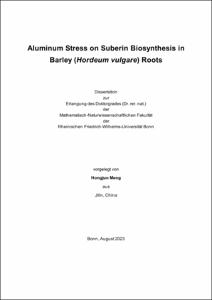Meng, Hongjun: Aluminum Stress on Suberin Biosynthesis in Barley (Hordeum vulgare) Roots. - Bonn, 2023. - Dissertation, Rheinische Friedrich-Wilhelms-Universität Bonn.
Online-Ausgabe in bonndoc: https://nbn-resolving.org/urn:nbn:de:hbz:5-71962
Online-Ausgabe in bonndoc: https://nbn-resolving.org/urn:nbn:de:hbz:5-71962
@phdthesis{handle:20.500.11811/11014,
urn: https://nbn-resolving.org/urn:nbn:de:hbz:5-71962,
author = {{Hongjun Meng}},
title = {Aluminum Stress on Suberin Biosynthesis in Barley (Hordeum vulgare) Roots},
school = {Rheinische Friedrich-Wilhelms-Universität Bonn},
year = 2023,
month = aug,
note = {Aluminum (Al) toxicity is a major factor inhibiting plant growth in acidic soils worldwide, and the root barrier formed by suberized cells is an important mechanism for plants to resist environmental stress. The aim of this study was to investigate the effect of Al stress on the synthesis of suberin in barley (Hordeum vulgare) roots and the role of suberin in resisting Al stress.
This study investigated the effect of different pH conditions on root development and suberin biosynthesis in barley seedlings, with a particular focus on the impact of Al stress and silicon supplementation. The results indicated that the length and dry weight of seminal roots in barley were not significantly affected by pH, but Al stress led to a noticeable reduction in root growth. However, the addition of Si to the solution medium containing 50 µM Al mitigated the adverse effects of Al stress on root growth. The results also showed that 4 days of Al stress could significantly increase the distribution and content of suberin in barley roots through FY staining observation and GC chemical analysis. The analysis of the aliphatic suberin monomer composition in various zones of barley roots grown under distinct pH conditions also showed no significant differences. However, the amount of suberin increased under Al stress, with Si supplementation leading to a reduction in suberin deposition. Analysis of RNA-seq data and qPCR analysis showed that Al stress could induce the expression of a series of genes related to suberin synthesis, among which the key gene for suberin synthesis, CYP86B1, was crucial in the Al stress response. Under Al stress, Al-induced suberization in the barley cyp86b1 mutants was significantly lower than in wild-type barley. In parallel, a series of ABA-related genes involved in ABA biosynthesis, degradation, and signalling were upregulated under Al stress, indicating that Al treatment could induce ABA synthesis and possibly regulate Al-induced suberization by modulating the ABA pathway. Furthermore, in the presence of the ABA synthesis inhibitor fluridone, Al stress could no longer induce changes in suberin. Morin staining showed that the presence or absence of suberin lamellae had a significant effect on the transport of Al in roots. In the absence of suberin, more Al entered the xylem of the root. However, after 4 days of Al treatment, the presence or absence of suberin did not affect the growth status of the barley aboveground part.},
url = {https://hdl.handle.net/20.500.11811/11014}
}
urn: https://nbn-resolving.org/urn:nbn:de:hbz:5-71962,
author = {{Hongjun Meng}},
title = {Aluminum Stress on Suberin Biosynthesis in Barley (Hordeum vulgare) Roots},
school = {Rheinische Friedrich-Wilhelms-Universität Bonn},
year = 2023,
month = aug,
note = {Aluminum (Al) toxicity is a major factor inhibiting plant growth in acidic soils worldwide, and the root barrier formed by suberized cells is an important mechanism for plants to resist environmental stress. The aim of this study was to investigate the effect of Al stress on the synthesis of suberin in barley (Hordeum vulgare) roots and the role of suberin in resisting Al stress.
This study investigated the effect of different pH conditions on root development and suberin biosynthesis in barley seedlings, with a particular focus on the impact of Al stress and silicon supplementation. The results indicated that the length and dry weight of seminal roots in barley were not significantly affected by pH, but Al stress led to a noticeable reduction in root growth. However, the addition of Si to the solution medium containing 50 µM Al mitigated the adverse effects of Al stress on root growth. The results also showed that 4 days of Al stress could significantly increase the distribution and content of suberin in barley roots through FY staining observation and GC chemical analysis. The analysis of the aliphatic suberin monomer composition in various zones of barley roots grown under distinct pH conditions also showed no significant differences. However, the amount of suberin increased under Al stress, with Si supplementation leading to a reduction in suberin deposition. Analysis of RNA-seq data and qPCR analysis showed that Al stress could induce the expression of a series of genes related to suberin synthesis, among which the key gene for suberin synthesis, CYP86B1, was crucial in the Al stress response. Under Al stress, Al-induced suberization in the barley cyp86b1 mutants was significantly lower than in wild-type barley. In parallel, a series of ABA-related genes involved in ABA biosynthesis, degradation, and signalling were upregulated under Al stress, indicating that Al treatment could induce ABA synthesis and possibly regulate Al-induced suberization by modulating the ABA pathway. Furthermore, in the presence of the ABA synthesis inhibitor fluridone, Al stress could no longer induce changes in suberin. Morin staining showed that the presence or absence of suberin lamellae had a significant effect on the transport of Al in roots. In the absence of suberin, more Al entered the xylem of the root. However, after 4 days of Al treatment, the presence or absence of suberin did not affect the growth status of the barley aboveground part.},
url = {https://hdl.handle.net/20.500.11811/11014}
}






